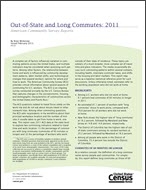Out-of-State and Long Commutes: 2011
Out-of-State and Long Commutes: 2011
A complex set of factors influences variation in commuting patterns across the United States, and multiple indicators may be considered when assessing such patterns. Among other factors, the relationship between home and work is influenced by community development patterns, labor market shifts, and technological changes that expand workers’ options for where and how to work. The American Community Survey (ACS) provides critical information about several aspects of commuting for U.S. workers. The ACS is an ongoing survey conducted annually by the U.S. Census Bureau that captures changes in the socioeconomic, housing, and demographic characteristics of communities across the United States and Puerto Rico.1
The ACS questions related to travel focus solely on the work trip and do not ask about leisure travel or other nonwork trips. Among other commuting questions, the ACS asks respondents in the workforce about their principal workplace location and the number of minutes it usually takes to get from home to work, one way. This report uses 2011 ACS data at the state level to explore two commuting indicators related to travel time and work location: (1) the percentage of commuters with long commutes (commutes of 60 minutes or longer) and (2) the percentage of workers who work outside of their state of residence. These topics are subsets of a much broader, more complex set of travel time and place indicators. The media occasionally discuss such commuting patterns within several contexts, including health, interstate commuter taxes, and shifts in the housing and labor markets. This report may serve as a baseline statistical reference point for such discussions. Unless otherwise noted, estimates refer to the working population who did not work at home.
Highlights
- Among U.S. workers who did not work at home, 8.1 percent had commutes of 60 minutes or longer in 2011.
- An estimated 61.1 percent of workers with “long commutes” drove to work alone, compared with 79.9 percent for all workers who did not work at home.
- New York shows the highest rate of “long commutes” at 16.2 percent, followed by Maryland and New Jersey at 14.8 and 14.6 percent, respectively.
- The District of Columbia has the highest rate of out-of-state commuters among its resident workers at 25.2 percent, followed by Maryland at 18.3 percent.
- Among all people who work in the District of Columbia, 72.4 percent live outside the District of Columbia.
__________
1 The ACS uses a series of monthly samples to produce annual estimates. Detailed questions that previously appeared on the decennial census long form are now included in the ACS, and the decennial census now produces a count of the nation’s population and a snapshot of its most basic demographic characteristics. Five years of ACS data collection are necessary to achieve a cumulative sample large enough to ensure respondent confidentiality for smaller communities and for small geographic units such as census tracts or block groups. For larger geographies, specifically those with populations of 65,000 or greater, estimates are available annually. For selected geographies with populations of 20,000 or greater, combined 3-year estimates are available.
Appendix Table A
Others in Series
Publication
Publication







